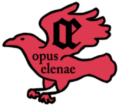Finished Project: Crow Cup Cover
It’s finally finished! I’ve had this as my SCA on-the-go project since Gulf War (which was in February, so it’s been a minute). I decided that I wanted to get it finished and usable, so I did a stitching spring to the finish line. I ironed the cover, but it sat in the hoop for […]
Finished Project: Crow Cup Cover Read Post »
